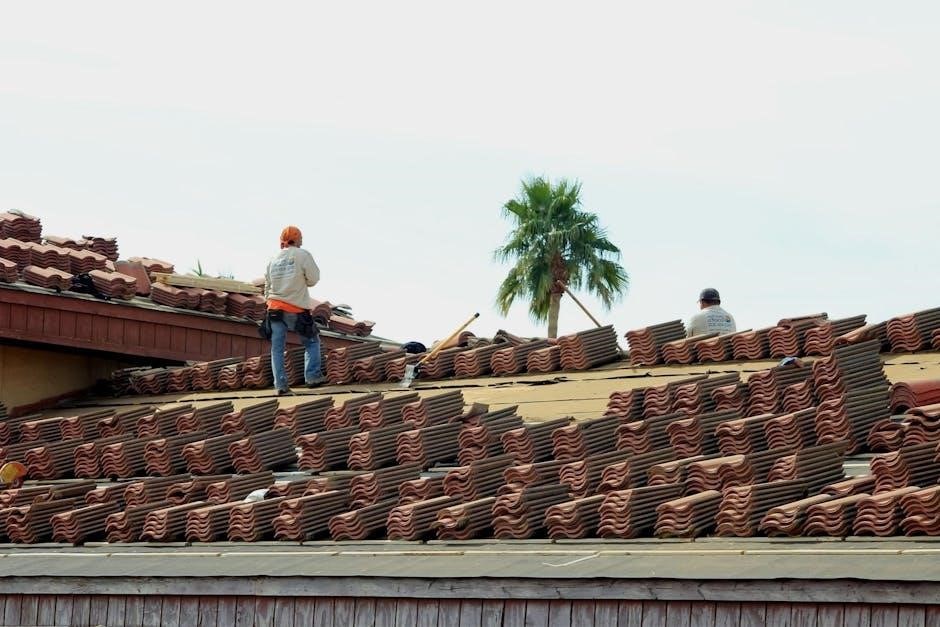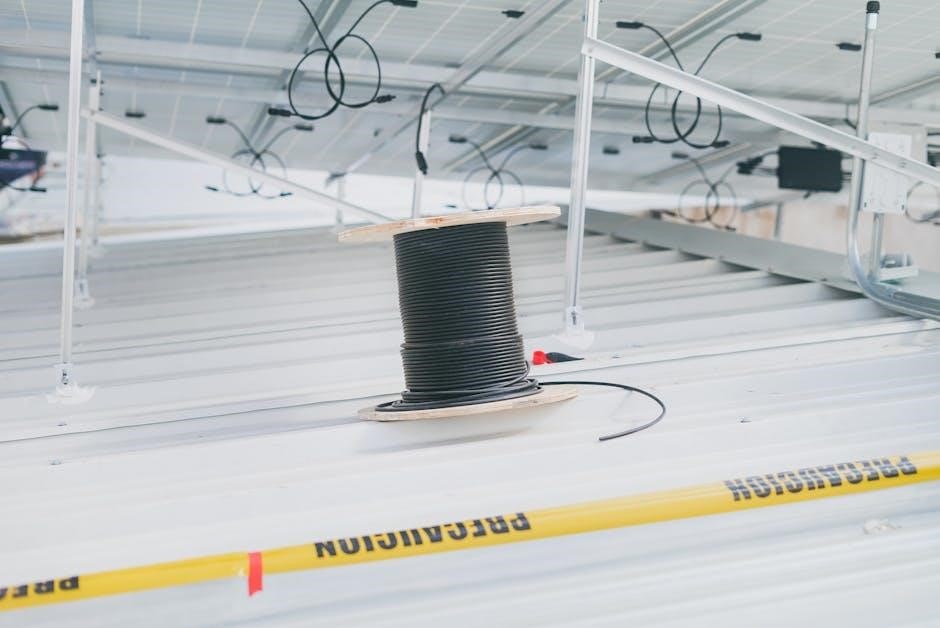Overview of Tile Roofing Systems
Tile roofing systems are designed to provide a durable and long-lasting solution for homeowners and builders․ The systems typically consist of a combination of components, including the roof deck, underlayment, and tile․ There are various types of tile roofing systems available, including clay, concrete, and composite systems․ Each type of system has its own unique characteristics and benefits, and the choice of system will depend on factors such as climate, budget, and personal preference․ The Florida High Wind Concrete and Clay Tile Installation Manual is a useful resource for understanding the requirements and best practices for installing tile roofing systems in high wind areas․ The manual provides detailed information on the design and installation of tile roofing systems, including the use of structural ribbing and hip and ridge caps․ By understanding the different types of tile roofing systems and their components, homeowners and builders can make informed decisions about their roofing needs․
Importance of Proper Installation
The proper installation of tile roofing systems is crucial to ensure their durability and performance․ A well-installed system can provide long-lasting protection against the elements, while a poorly installed system can lead to costly repairs and maintenance; The Tile Roofing Industry Alliance emphasizes the importance of proper installation, providing resources and training for installers to ensure that tile roofing systems are installed correctly․ The alliance also provides guidance on code development and education to promote best practices in the industry․ Proper installation involves careful attention to detail, including the use of correct flashing and sealing techniques, to prevent water infiltration and other issues․ By prioritizing proper installation, homeowners and builders can enjoy the benefits of a tile roofing system, including its aesthetic appeal and durability․ The importance of proper installation cannot be overstated, as it is essential to ensuring the longevity and performance of the system․

Pre-Installation Requirements
Pre-installation requirements include detailed plans and specifications for accurate interpretation of project needs and requirements online now easily and quickly through various technical support portals available․
Design and Planning Considerations
Design and planning considerations are crucial for a successful tile roof installation, requiring careful evaluation of various factors such as roof slope, size, and shape, as well as local building codes and regulations․
Access to online resources and technical support portals can provide valuable guidance and information on design and planning considerations, including detailed plans and specifications for accurate interpretation of project needs and requirements․
Additionally, resources such as the Florida High Wind Concrete and Clay Tile Installation Manual can offer valuable insights and guidance on design and planning considerations for high wind applications, ensuring a safe and durable roof installation․
By carefully considering these factors and utilizing available resources, homeowners and builders can ensure a well-designed and well-planned tile roof installation that meets their needs and provides long-lasting performance․
Online resources can also provide information on the latest developments and advancements in tile roof installation, allowing for informed decision-making and optimal results․
Obtaining Necessary Permits and Approvals
Obtaining necessary permits and approvals is a critical step in the tile roof installation process, ensuring compliance with local building codes and regulations․
State agencies and local authorities require specific documentation and inspections to approve tile roof installations, and online resources can provide guidance on the necessary procedures and requirements․
The Office of Sustainability can also provide information on obtaining permits and approvals for electric vehicle infrastructure and other related installations․
Additionally, resources such as the Tile Roofing Industry Alliance can offer valuable information on code development and compliance, helping to streamline the permitting and approval process․
By understanding the necessary permits and approvals required for tile roof installation, homeowners and builders can avoid delays and ensure a smooth installation process, and online resources can provide the necessary tools and guidance to facilitate this process, making it easier to obtain the required permits and approvals․

Tile Roof Installation Process
Tile roof installation process involves preparing roof deck, installing underlayment and tiles, following specific guidelines and manufacturer instructions for lasting performance and durability always online․
Preparing the Roof Deck
Preparing the roof deck is a crucial step in the tile roof installation process, it involves inspecting the deck for any damage or rot, and making necessary repairs to ensure a solid foundation for the tiles․
The deck should be clean and free of debris, with all old roofing materials removed, and any uneven areas should be leveled to provide a smooth surface for the underlayment․
A roof deck that is not properly prepared can lead to a variety of problems, including leaks, cracks, and structural damage, so it is essential to take the time to do it correctly․
The installation guide provides detailed instructions on how to prepare the roof deck, including the use of specific materials and tools, and following the manufacturer’s instructions is crucial to ensure a successful installation․
By taking the time to properly prepare the roof deck, homeowners can help ensure that their tile roof will last for many years, and provide the protection and durability they need․
The process of preparing the roof deck requires patience and attention to detail, but the end result is well worth the effort, a beautiful and durable tile roof that will enhance the appearance and value of the home․
Installing Underlayment and Tile
Installing underlayment and tile is a critical step in the tile roof installation process, requiring careful attention to detail to ensure a watertight seal․
The underlayment material should be applied to the entire roof deck, overlapping the edges to prevent water from seeping underneath․
The tile installation process typically begins at the bottom edge of the roof, working upwards to allow for proper water runoff․
Each tile should be carefully aligned and secured to the underlayment, using the recommended fastening system to prevent damage from wind and weather․
The installation guide provides specific instructions on how to install underlayment and tile, including the use of specialized tools and materials․
By following the manufacturer’s instructions and taking the time to ensure a proper installation, homeowners can enjoy a beautiful and durable tile roof that will provide years of protection and satisfaction․
The correct installation of underlayment and tile is essential to prevent leaks and other problems, and to ensure the longevity of the roof․

Post-Installation Inspections and Maintenance
Regular inspections and maintenance ensure tile roof longevity and performance, checking for damage and wear online resources provide guidance and support for homeowners and professionals easily․
Ensuring Compliance with Building Codes
Ensuring compliance with building codes is crucial for tile roof installation, as it affects the safety and durability of the structure․ The 7th Edition Florida High Wind Concrete and Clay Tile Installation Manual provides guidelines for high wind applications in Florida․
State agencies and homeowners can access resources and training on the BRAVA Technical Support Portal to ensure compliance with building codes and regulations․ The portal offers updates on structural ribbing from hip and ridge caps, as well as specifications for composite roof tiles․
Additionally, the Tile Roofing Industry Alliance provides education and training on clay and concrete tile roofs, including code development and compliance․ By following these guidelines and resources, homeowners and professionals can ensure that their tile roof installation meets the required building codes and regulations, guaranteeing a safe and durable structure․
Regular Maintenance and Repair
Regular maintenance and repair are essential for extending the life of a tile roof․ The roof should be inspected annually for damaged or missing tiles, and repairs should be made promptly to prevent further damage․
A routine maintenance checklist should include inspecting the roof’s flashing, gutters, and downspouts to ensure they are functioning properly․ Additionally, trimming tree branches and clearing debris from the roof can help prevent damage from falling objects․
Homeowners can also refer to the tile roof installation guide pdf for specific maintenance and repair instructions, as well as recommendations for cleaning and inspecting the roof․ By following these guidelines, homeowners can help ensure their tile roof remains in good condition and continues to provide protection and durability for years to come, with minimal need for costly repairs or replacement․ Regular maintenance is key to a long-lasting tile roof․

and Additional Resources
For additional resources, homeowners can visit the website of the Tile Roofing Industry Alliance, which offers a range of educational materials and training programs for clay and concrete tile roofs․ Furthermore, manufacturers such as Brava Roofing Products provide online resources and support for their composite roof tiles, including specifications and installation guides․
By consulting these resources and following the guidelines outlined in the tile roof installation guide pdf, homeowners can ensure a successful and stress-free installation process, and enjoy the benefits of a beautiful and durable tile roof for years to come, with access to ongoing support and maintenance guidance․

